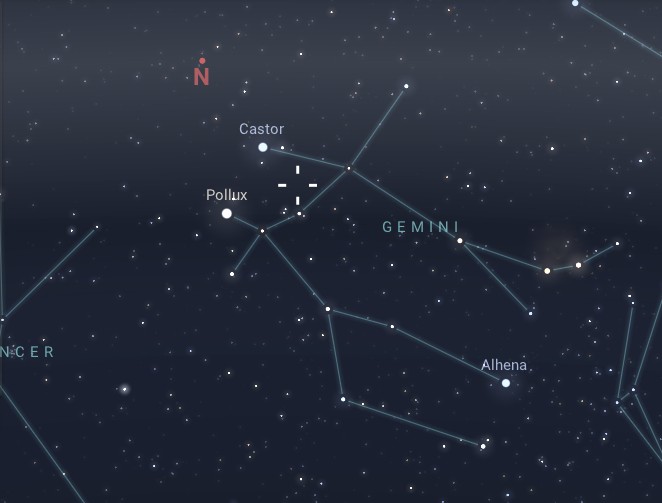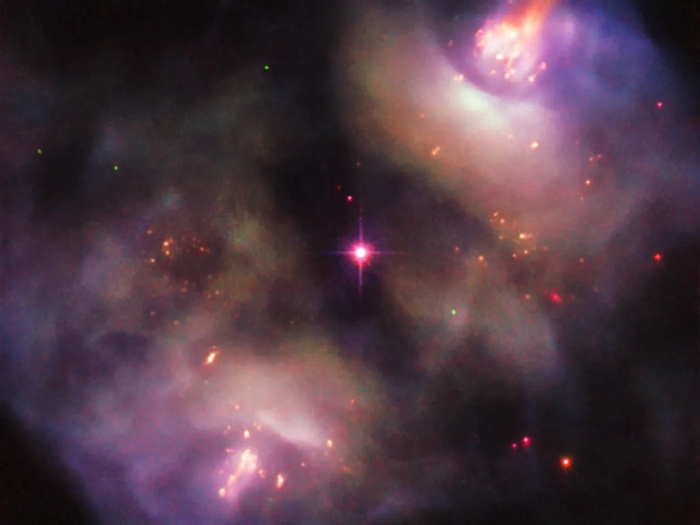NGC 2371-2 is a planetary nebula located in the northern constellation of Gemini. It was discovered by the German-born British astronomer Sir William Herschel in 1785. This intriguing nebula is often listed under two designations, NGC 2371 and NGC 2372, due to its bipolar appearance. Below is more detailed information about this fascinating deep-sky object.
Location
NGC 2371-2 is located in the constellation Gemini, which represents the mythological twins, Castor and Pollux. Gemini is a prominent constellation in the northern celestial hemisphere and is easily visible from both hemispheres during the winter and early spring months. Gemini lies along the ecliptic, making it one of the zodiac constellations. The nebula is situated near the bright star Castor, making it relatively easy to locate with a telescope despite its faintness.
Physical Characteristics
The nebula is estimated to be about 3,800 light-years away from Earth. At its heart lies a binary star system, consisting of two white dwarf stars in close orbit. These white dwarfs are the remnants of the original star that shed its outer layers to form the surrounding nebula. The intense ultraviolet radiation from these white dwarfs ionizes the surrounding gas, causing it to emit the light that makes the nebula visible. The temperature of these white dwarfs is extremely high, likely exceeding 100,000 K, which is typical for stars in this stage of evolution.
Morphology
NGC 2371-2 is a classic example of a bipolar nebula, characterized by its two lobes of material extending symmetrically from the central star system. These lobes are thought to form due to the interaction of the stellar winds and outflows with the surrounding interstellar medium. The bipolar shape suggests that the material was ejected along preferred directions, possibly influenced by the rotational axis of the central binary stars. This nebula also contains knots and filamentary structures, adding to its complexity and beauty.
The nebula’s bipolar shape and dual-lobed structure are significant because they provide clues about the dynamics of stellar evolution and the mass-loss processes that occur in the final stages of a star’s life. The symmetrical outflows suggest that the ejection of material was likely influenced by the binary nature of the central system.
Size and Brightness
In terms of apparent size, NGC 2371-2 spans about 1.4 arcminutes across the sky, which is relatively small for a planetary nebula. Its visual magnitude is around 12.4, meaning it is faint and challenging to observe. A telescope with a moderate to large aperture is required to clearly resolve the nebula’s structure. Given its faintness, it is not visible in smaller telescopes under typical suburban sky conditions. However, under dark skies, it becomes a rewarding target for skilled observers.
Evolutionary Stage
NGC 2371-2 is in the final stages of stellar evolution for its central star system. The central stars have undergone significant mass loss, ejecting their outer layers in the form of gas and dust, which now forms the visible nebula. Over time, the nebula will continue to expand and dissipate into space, becoming part of the interstellar medium. The binary system at the nebula’s core will cool down and fade, ultimately becoming two cold, faint white dwarfs. The life cycle of stars like the one that created the nebula plays an essential role in enriching the interstellar medium with heavy elements necessary for forming new stars and planetary systems.
Observation
NGC 2371-2 can be observed primarily from the Northern Hemisphere during the winter and early spring months, particularly from December through March. During this period, the constellation Gemini is high in the sky during the evening hours, providing optimal observing conditions. The nebula is located near Castor, one of the brighter stars in the constellation, which serves as a useful guide.

However, observing NGC 2371-2 can be difficult due to its faintness and small size. A moderate to large-aperture telescope is necessary to resolve its structure, and good observing conditions are essential. The use of narrowband filters, particularly an OIII (doubly ionized oxygen) filter, can significantly enhance the contrast and visibility of the nebula, as these filters highlight the emission lines produced by ionized oxygen in the nebula. Clear, moonless nights and dark-sky locations are recommended for the best possible views.
For those with larger telescopes, the bipolar nature of the nebula can be appreciated, with its two distinct lobes and central region often appearing in images or through high-magnification observation. Its faint structure and detailed morphology make it a fascinating target for deep-sky enthusiasts interested in planetary nebulae.



